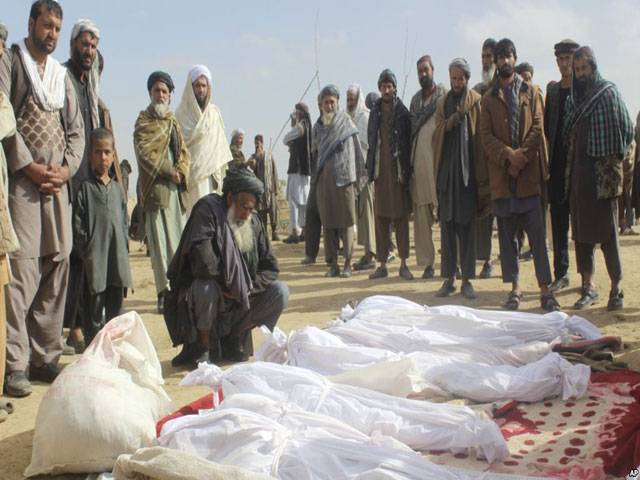JALALABAD - Several civilians have been killed in an US airstrike in eastern Afghanistan, local officials said Friday, the latest setback in efforts to bring peace to the war-torn country.
Saaz Wali Shinwari, the district governor of Haska Mina in Nangarhar province, said the raid was carried out by US troops although there was no official confirmation from NATO.
“On Thursday afternoon, the American forces bombarded a civilian private vehicle... when they were travelling inside the district,” he told AFP. “Unfortunately, in the airstrike we have casualties. Eleven people were killed and one wounded. All the victims, which included women and children, were civilians and they were from one family.
“The victims were beyond recognition, and they were placed inside the sacks and were buried late last night,” he added. Of the roughly 13,000 foreign forces in Afghanistan only the United States carries out airstrikes.
They have been regularly targeting Islamic State insurgents who control several districts in restive Nangarhar.
Dawlat Waziri, a spokesman for Afghanistan’s defence ministry, said the strike was carried out by foreign forces in coordination with Afghan officials.
“In the strike, five insurgents were killed and two others were wounded. “We do not have any news about civilian casualties. But, we have appointed a delegation to investigate if civilians are killed,” he told AFP. NATO said they were unable to provide any information when contacted by AFP. Attaullah Khogyani, a spokesman for the Nangarhar provincial governor, said an unknown number of civilians had died but was unable to say who carried out the strike.
“I can confirm an airstrike in Haska Mina district of Nangarhar province and it led to civilian casualties. For the time being, we do not have a precise figure about the casualties,” he told AFP.
Meanwhile, the Afghan Taliban and Islamic State attacked a village in the northern province of Sar-e Pul this week, killing between 50-60 people, a leading Afghan human rights group said on Friday.
The Taliban, seeking to restore Islamic rule after their 2001 ouster, rejected statements that the attack on Mirza Olang was a joint operation with the local affiliate of Islamic State, saying they acted alone and had targeted security forces.
However the Afghanistan Independent Human Rights Commission said a preliminary investigation suggested that the two groups, which are normally bitter rivals, acted together.
“Evidence shows that this brutal crime has been committed by the Taliban in collusion with the ISIS group,” the AIHRC said in a statement, based on what it said was “extremely shocking and terrible” witness testimony.
The attack on Mirza Olang has highlighted the dire security situation in many provincial areas of Afghanistan, where the government controls no more than 60 percent of territory and where armed militant groups operate freely in many areas.
Any cooperation between the Taliban and Islamic State would cause alarm in both the Afghan government and the United States which keeps thousands of troops in a counter-terrorism mission in Afghanistan to fight groups like ISIS and al Qaeda.
Villagers who escaped Mirza Olang had previously told reporters that they saw fighters carrying both the white banner of the Taliban and the black banner of Islamic State.
But in a region where different bands of fighters often switch between different militant groups, it can be difficult to establish allegiances with any certainty.
The AIHRC report quoted witnesses as saying the attack was led by a Taliban commander called Mullah Nader and an Islamic State commander called Ghazanfar. However Ghazanfar has previously been identified by Taliban officials as one of their commanders.
The AIHRC report said between 50 and 60 people, including five women and three children, had been killed in the attack, quoting a witness who said victims’ hands were tied before they were shot. In addition, three people were beheaded.
It said the insurgents had taken the village after two days of fighting with local security forces and local militia fighters, killing cattle and destroying property.
In total 471 families had fled the village to nearby villages and the provincial capital Sar-e Pul and they required urgent humanitarian assistance, the AIHRC statement said.






